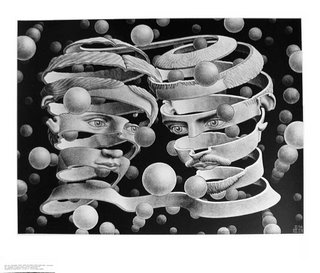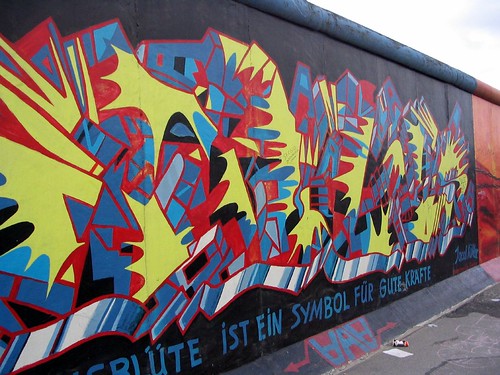
“Thinking of Holland I see wide rivers, slowly flowing through endless low-lying land,
Inconceivably gossamer poplars on the horizon in wispish ranks” (freely translated, by dr. John Irons)
This may very well be the most famous lines of poetry in Dutch literature. Many readers will be able to proclaim them, but even more will recognize the feeling that is behind it. The fact that such lines can evoke this feeling is the basis for some good old-fahioned nostalgia and the everythinh-used-to-be-so-much-better-mentality you find with nearly everyone over the age of fifteen. Hendrik Marsman, the author of the forementioned lines clearly experiences the mental images of rivers and poplars when he thinks back of the Dutch landscape. But why, and how does this work? How can he see things that aren’t there, merely by thinking of them. Apparently seeing by memory is something our brains are able to do. The obvious next question would then be how the brain knows which images are physical and which are mental. Coincedentally I received an email last week from someone I got to know when I was living in Portland, USA. He suggested I should watch the movie “What the Bleep do we know”, partly because it was filmed in Portland and would be a nice trip through memory lane, but also because it adresses consciousness from a quantum physics point of view and wasn’t that just one of my major interests? With a healthy load of expectation I started watching the movie and it started off really in teresting. The movie tells the story of a photographer that slowly learns that her ideas and emotions aren’t reality but products created by her own consciousness. This story is intertwined with quotes of wise scientists or people that are supposed to be wise scientists. They talk about quantum physics, consciousness and neural processes. While in the beginning these intermezzos speak to the imagination, they soon turn into a spiritual manifesto of biased, pseudo-scientific nonsense. It were mainly the ocassional shots of Portland that made that I finished the movie. Although in the end there was not a lot of science left in the movie it did get me thinking. The ancient question of whether a falling tree makes a sound if no-one is there to hear it got an entirely new dimension when I asked myself whether without perception anything actually exists at all.
The basic idea that is central to this movie is based on quantum physics’ supersition principle. Elementary particles do not have a fixed position until you force them to take a form and position by perceiving or measuring them. The same principle is applied to reality, it would not have a defined shape until we perceive it. The most important error of reasoning here is a very common mistake. Laws that apply to a certain level of processes do not necessarily apply to another. Quantum physics is about elementary particles and even if it sounds great in theory rivers and poplars cannot be classified as such. But even with all this criticism there are two aspects of the movie that do have a scientific basis.
Quantum consciousness
In modernneurobiology there are theories that relate quantum physics to consciousness, but in a fundamentally different way than “What the bleep” wants us to believe. The question how thoughts arise from the grey matter and what gives rise to consciousness has accopied scientist for centuries. The reasoning to initially link thoughts and consciousness to quantum physics lays in the fact that thought are non-algorithmic. The only other known non-algorithmic processes are randomn processes and quantum processes. Since randomness does not seem to be an appealing explanation for consciousness an explanation is being sought in quantum processes. It is of course doubtable whether this is a valid argument. David Chalmers, philosophy professor at the Australian National University calls this ‘minimizing the mysteries’; The blunt fact that both consciousness and quantum physics are extremely complex and hard for us to understand does not mean they have anything to do with each other. Apart from this valid criticism there are some interesting theories that involve quantum processes to explain consciousness. The most popular of these theories is probably the Orchestrated Objective Reduction (Orc OR) model of Roger Penrose and Stuart Hameroff, that assigns quantum processes to microtubuli in our neurons. In short and very much simplified, a tubulin protein in the microtubuli of neurons can have two distinct 3d-configurations, which could in theory be in superposition. By means of interactions between tubulin-proteins and a spread of quantum states over neural networks through gap junctions between neurons, the brain could be the seat of a kind of “quantum computer” that gives rise to consciousness. Opposed to the initial enthusiasm about this theory there is a fair load of criticism. According to quantum theory, quantum processes occur at extremely low temperatures, whereas neurons are at body temperature, which is approximately 37 degrees celsius. Furthermore microtubli are present in all eukaryotic cells (cells with a nucleus), does this meanthat every eukaryotic cell is conscious? Although there are answers possible to these questions it would be too much to discuss them here. The issue that is important to me is that new theories tend to be embraced by science as the answer to all outstanding questions. This is inprinciple fine, but should be regarded with a healthy dosis of scepticism. Positively it expands are view of possible new solutions for old problems but negatively it can lead to hasty conclusions and a unhealthy amount of wishful thinking. It often happens that theories are taken out of context and abused in another field of of expertise. A lack of general knowledge about such new theories can easily facilitate made-up messages wrapped in (pseudo)science to be be accepted as true. This is exactly what happens in “What the bleep”. When two fascinating but far from ccomplete theories from quantum physics and neurobiology are presented as a solution to the problem of consciousness, covered with a sick-making spiritual sauce, it is simply a case of mis-information and propaganda. The problem of consciousness is not solved by it at all. The sequel for “What the bleep” is scheduled to appear shortly and is titled “Down the rabbit hole”, which refers to one of my favourite books of all time “Alice in Wonderland”, by Lewis Caroll. The leading figure in this book, Alice, descends through a rabbit hole into a weird world were nothing seems to be following the laws of physics. A world that is only obeying its own supernatural laws, just like the worlds of qauntum physics and consciousness.
Vision and the brain
When Alice encounters a large blue caterpillar in Wonderland, an intersting conversation takes place;
`Who are YOU?' said the Caterpillar. This was not an encouraging opening for a conversation. Alice replied, rather shyly, `I--I hardly know, sir, just at present-- at least I know who I WAS when I got up this morning, but I think I must have been changed several times since then.' `What do you mean by that?' said the Caterpillar sternly. `Explain yourself!' `I can't explain MYSELF, I'm afraid, sir' said Alice, `because I'm not myself, you see.' `I don't see,' said the Caterpillar. `I'm afraid I can't put it more clearly,' Alice replied very politely, `for I can't understand it myself to begin with; and being so many different sizes in a day is very confusing.' `It isn't,' said the Caterpillar.
This fragment shows how aour sense of self and our consciousness can get very confused in a world that does not act like “it is supposed to”. It also shows that perception is very personal. The visual system is responsible for a large portion of our perception of the world, but because we each have our own visual visual system, and perception is personal, we each have our own world. I deliberately use the term visual system instead of eyes, because seeing is more a matter of the brain than it is of the eyes. Some kinds of seeing are very well possible even without eyes altogether (Thinking of Holland etc..). That seeing with the eyes and seeing with the brain are distinct processes is most clearly shown by a type of pictures we call ambiguous or bi-stable. Famous examples are the Necker Cube, with two possible perspectives, Jastrows Duck-Rabbit picture and the Wife/Mother-in-Law picture. While the stimulus and the retinal image remain physically the same, the conscious percept changes over time indicating that vision is not as simple and self-evident as we think it is. Different aspects such as memory, emotion, attention and context are essential in our visual perception. This has the strong implication that there can never something as “the reality” or “the real world” because it is always en interpretation. It os “our reality” or “our real world”. The fine mental cover of Marcel Proust’ is still firmly in place. Our entire civilization is build on interpretations and assumptions, the main assumption being that we all perceive more or less the same, and have the same kind of emotions under similar circumstances. At the level of the individual we are already living in one big illusion since we can only perceive a tiny part of the perceivable world and have to fill in, assume and interpretate the rest. The substance of the little parts we do perceive is determined by many processes, concidence being one of them. In “What the bleep” quantum physics is used to solve this problem as well. There is no real world because the world is in superposition and perception colapses the waveform forcing the world to become an interpretation that is restricted to the personal experience of the perceiver. This solution is as absurd as it is untestable.
The value of new theories
If I return to Dutch literature I would like to mention the following famous line:
“...but between dream and reality, are laws in the way, and practical objections” (translated by myself)
Although I took this completely out of context, it does show us the essence of our problem. If I would rephrase the sentence it would make this more clear:
“...but between perception and reality, is knowledge in the way, and personal interpretation”
Nothing is as it seems, but at the same time time everything is as it seems. Since we cn never really know the true nature of reality, the most pure form of reality will be “our interpretation of reality”. The world that we perceive and the world that we live are the same, but cannot be reasoned together. Some time ago, someone introduced me to the term “Divine Hole”, for the emptiness between the world of reason and the world of feeling. It made sense, and it still does. Einstein was said that a problem cannot be solved with the same reasoning that created it. I don’t think I totally with him on that point, but I must admit that a fresh point of view can often be benificial for life in general and science specifically. We must however remain as critical as Popper would want us to be. Welcome new theories but do not embrace them as the answer to all our problems prematurely, that way new theories may bring us closer to an explanation for classic issues like consciousness. It is however of the utmost importance to do so in an honest and sensible way. In the case of “What the bleep” many standards of scientific decency have been ignored by taking pieces of fine scientific theories and copy-paste together into some kind of collage of a spiritual manifesto. I have explained why I can not speak for anyone else, but in my personal opinion this is wrong, no matter what superposition my brain is in.









